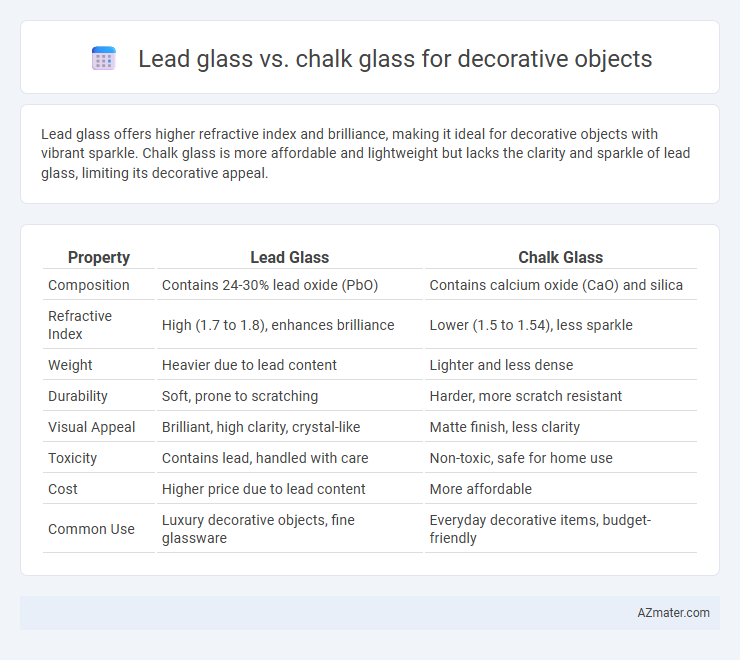Lead glass offers higher refractive index and brilliance, making it ideal for decorative objects with vibrant sparkle. Chalk glass is more affordable and lightweight but lacks the clarity and sparkle of lead glass, limiting its decorative appeal.
Table of Comparison
| Property | Lead Glass | Chalk Glass |
|---|---|---|
| Composition | Contains 24-30% lead oxide (PbO) | Contains calcium oxide (CaO) and silica |
| Refractive Index | High (1.7 to 1.8), enhances brilliance | Lower (1.5 to 1.54), less sparkle |
| Weight | Heavier due to lead content | Lighter and less dense |
| Durability | Soft, prone to scratching | Harder, more scratch resistant |
| Visual Appeal | Brilliant, high clarity, crystal-like | Matte finish, less clarity |
| Toxicity | Contains lead, handled with care | Non-toxic, safe for home use |
| Cost | Higher price due to lead content | More affordable |
| Common Use | Luxury decorative objects, fine glassware | Everyday decorative items, budget-friendly |
Introduction to Decorative Glass Types
Lead glass offers superior clarity and brilliance due to its high refractive index, making it ideal for decorative objects that emphasize sparkle and elegance. Chalk glass, characterized by its opaque, milky appearance, provides a softer, matte finish suited for artistic and vintage-style decorations. Both glass types serve distinct aesthetic purposes, with lead glass favored for crystal-like effects and chalk glass chosen for diffused light and subtle texture.
Overview of Lead Glass
Lead glass, known for its high refractive index and exceptional clarity, enhances decorative objects with brilliant sparkle and depth. Its composition, containing typically 24-30% lead oxide, increases density and weight, making items feel substantial and luxurious. Compared to chalk glass, lead glass offers superior brilliance and improved durability, making it the preferred choice for high-end decorative pieces.
Overview of Chalk Glass
Chalk glass, also known as opaque white glass, is characterized by its smooth, matte finish and milky appearance, making it a popular choice for decorative objects that require a soft, understated aesthetic. Unlike lead glass, which contains high lead oxide content for brilliance and clarity, chalk glass is primarily composed of silica with added tin oxide or calcium compounds to achieve opacity and durability. Its cost-effectiveness and resistance to chipping make chalk glass ideal for ornamental items like vases, figurines, and lamp bases where translucency and intricate designs are less critical.
Key Differences Between Lead Glass and Chalk Glass
Lead glass contains lead oxide, which increases its density, brilliance, and refractive index, making it highly suitable for decorative objects requiring exceptional sparkle and clarity. Chalk glass, primarily composed of calcium oxide, has lower density and refractive index, resulting in a more muted luster and less weight, ideal for designs emphasizing subtle elegance or durability. The higher lead content in lead glass also enhances its workability and ability to be finely cut or engraved compared to the harder, more brittle nature of chalk glass.
Durability and Strength Comparison
Lead glass exhibits superior durability and strength compared to chalk glass due to its higher density and lead oxide content, which enhances its resistance to impact and scratches. Chalk glass tends to be more brittle and prone to chipping, making it less ideal for decorative objects that require long-lasting resilience. For decorative items demanding robustness and longevity, lead glass offers a more reliable and enduring option.
Visual Appeal: Clarity and Shine
Lead glass exhibits superior clarity and brilliance due to its high refractive index, producing a dazzling sparkle that enhances decorative objects. Chalk glass, made from soda-lime composition, offers less clarity and lower shine, resulting in a more muted appearance. The enhanced light dispersion in lead glass makes it the preferred choice for visually striking decorative pieces requiring exceptional clarity and shine.
Health and Safety Considerations
Lead glass, containing high levels of lead oxide, offers superior clarity and brilliance but raises health concerns due to lead toxicity, especially if used for objects in contact with food or drink. Chalk glass, primarily composed of calcium oxide, is a safer alternative with no toxic risks, making it more suitable for decorative items in homes and public spaces. When choosing materials for decorative objects, prioritizing lead-free chalk glass reduces potential lead exposure and complies with modern health and safety regulations.
Cost and Accessibility
Lead glass typically costs more than chalk glass due to its higher lead oxide content, which increases weight and brilliance, making it a premium choice for decorative objects. Chalk glass, also known as soda-lime glass, is more affordable and widely accessible, produced using common raw materials and standard manufacturing processes. The cost difference and availability make chalk glass a practical option for budget-conscious decorative projects, while lead glass suits luxury designs requiring enhanced clarity and brilliance.
Popular Applications in Decorative Objects
Lead glass is favored in decorative objects for its high refractive index and brilliance, making it popular in luxury items like chandeliers, intricate figurines, and fine tableware. Chalk glass, or soda-lime glass, is commonly used for everyday decorative objects such as vases, candle holders, and ornamental jars due to its affordability and ease of shaping. The choice between lead glass and chalk glass largely depends on the desired aesthetic quality and budget constraints in decorative applications.
Which Glass Type is Best for Your Decor?
Lead glass offers superior brilliance and clarity due to its high refractive index, making it ideal for decorative objects that require a luxurious, sparkling appearance. Chalk glass, with its more opaque, milky texture, provides a unique, soft aesthetic but lacks the radiant shimmer of lead glass. For decor purposes where elegance and light reflection are key, lead glass is generally the best choice.

Infographic: Lead glass vs Chalk glass for Decorative object
 azmater.com
azmater.com